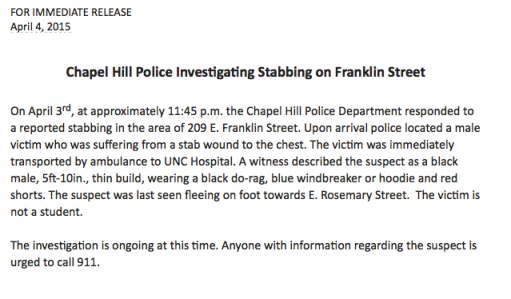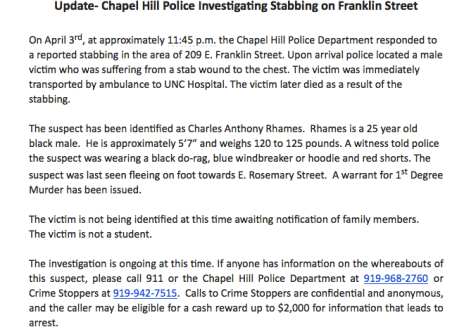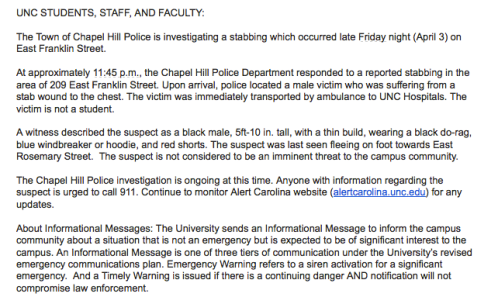It’s not really a problem with Alert Carolina, I suppose. It’s a problem with the way all police departments describe their suspects. And the way many media outlets mindlessly regurgitate that information without really considering its effects on readers.
So here’s how I first found out about last night’s stabbing:
This email is actually far better than most. Normally, the Chapel Hill Police Department only issues statements that give a suspect’s race, height and build. Nothing about what he/she is wearing. Nothing about where he/she might be — even though police typically have a pretty good idea about that stuff.
It’s detrimental because it creates unnecessary fear for readers. If all a newspaper prints is that a six feet tall white man was suspected to have committed a crime, then, suddenly, every six foot tall white man becomes a suspect. That information isn’t helpful.
But we at least got a description of his clothing. And we know he fled toward Rosemary Street. Here’s what I got next from police early this morning:
This next email gives us a name. That means if people recognize this name, they’ll know to call CrimeStoppers and give any information they have.
And Alert Carolina, always several hours behind, regurgitates the same information from the Chapel Hill Police Department.
I hadn’t really thought about this problem — and how I might be a part of it as someone who reported on crime a lot during my junior year as the city desk editor — until I read Inside Higher Ed’s story about the University of Minnesota’s decision to no longer include racial identifiers in some of their crime alerts.
Here‘s the story and here’s the most insightful (albeit disappointing) nugget I took from it:
Minnesota officials said they had analyzed 51 crime alerts since 2012 that included descriptions of suspects. In about 30 percent of those cases, there was so little detail that, under the new policy, racial and other characteristics would not be shared in the future. In the other cases, however, the university study found that there was legitimate reason to include the identifying characteristics.
First of all, props to the students who took over a building to effect such massive change. That’s awesome activism. But here’s their response to the University’s decision to exclude racial identifiers from only some of its crime alerts:
“Why does the administration think removing racial descriptors from only a third of crime alerts is sufficient, when racialized crime alerts feed a system that literally kills black people daily in this country? This is to say nothing of how constant threats to the safety of black students impact their studies, mental health and ability to graduate — racialized crime alerts have consequences far more pervasive and consequential than mere ‘feelings’ in the lives of students of color. Racialized crime alerts put the psychological, academic and physical survival of students of color on the line. It must be asked: How committed is the administration to truly ensuring that Black lives matter on this campus? On what side of history does the university administration want to be?”
I guess this whole story just taught me to be more aware of what I’m printing and the psychological effects it could have on my readers. I don’t want to print any information that’s unhelpful. I don’t want to be part of the problem.
Instead, I’ll be part of the solution. As a journalist, I’ll try to never include racial identifiers in stories unless it’s completely necessary or relevant to the subject matter — which right now, in my morning sleepiness, I can’t really think of a time when I would have to do that.



Twenty years ago, my newspaper decided that to include a person’s race in a crime story, the description had to have at least four or five other descriptors. Height, weight, clothing, etc.
Readers who wanted to know a suspect’s race were frustrated and complained. Our explanation was exactly what you say above. A 6-foot-tall, 175-pound white male doesn’t tell you anything of value. (I think that may have changed since the paper has new leadership.)
LikeLike